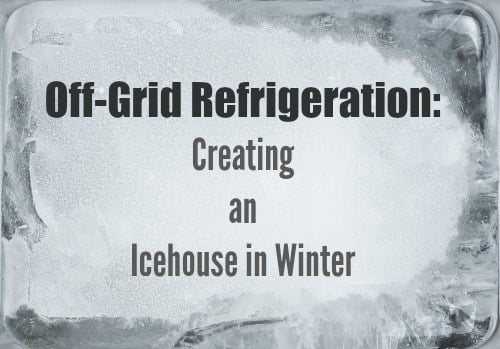
TRUMP SAYS: HUNTER MAKES FORTUNE FROM SHADY DEALS!
BIDEN FAMILY STINKS TO HIGH HEAVENS OF CORRUPTION!
DON'T GET LEFT OUT: HUNTER MUST BE STOPPED!

This article was originally published by Jeremiah Johnson at Tess Pennington’s Ready Nutrition on February 21, 2017.

For those without enough property or in an urban or suburban area, an icebox might be a good thing to have, at least as a backup for the refrigerator.
Those who plan to create ways for off-grid refrigeration usually plan to build when the snow thaws, but I’m doing something a little different – I’m planning on building one now. The main problem for me right now is that I have four feet of snow on the ground, and it’s a little hard to do a layout or any kind of excavating for it. But what of it? That doesn’t mean I can’t plan now, nor undertake it before the winter months disappear.
Icehouses were used extensively in the U.S., especially in “pioneer days,” where they would be the main way of keeping meats and vegetables cool and “refrigerated” in a manner to not require canning, smoking, or drying them. These icehouses were combined with root cellars/canning cellars to be structures heavily-insulated with earth to keep everything cool and from spoiling in the spring and summer months. I also mentioned an “icebox,” meaning a refrigerator that was not dependent upon electricity but had a large block of ice inside of an insulated “box” that kept the food inside cool and from spoiling prematurely.
For those without enough property or in an urban/suburban area, an icebox might be a good thing to have, at least as a backup for the refrigerator. If you have a little bit of ground, then you may be able to build an icehouse. I plan on beginning mine about the end of March to the beginning of April. See, living in Montana, where there are no building codes in rural areas, I’m not hindered by the need for permits or the usual parade of bloodsuckers from local or state governments or neighborhood (incarceration-hood, is more appropriate) associations. Thus, the benefit of living in a remote state, I can build whatever I want and nobody can say anything to me.
If you don’t have this, then you’ll have to negotiate around whatever “primates” are blocking your path and secure whatever permits you believe necessary if you want it done. I’m going to wait until the time I mentioned and then clear out the ground and the snow, use a “C” to dig (a miniature backhoe) the icehouse out, and then build it during the winter months. The reason is that I will make about a dozen and a half “molds” to fill with water for my ice-blocks, using large bins. When the water freezes and huge blocks of ice are made, I will then place them inside of my icehouse and cover them up with lots and lots of sawdust. Each block will have about 20 gallons of water, and this will be (at 7.6 lbs. per gallon) about 150 lbs. apiece. A lot easier to let the winter freeze-up those blocks!
I plan on placing in a drain into the floor (PVC drain tile) with a small slope and then tamping the earth back into place. Then I’ll separate the main chamber for the canned goodies from the ice chamber in the rear and slightly lower than the main room. Stacking the blocks up and then covering them all with sawdust, it will adhere to the time-honored principle of the frontier days…it will keep all spring and summer, and have to be replaced in the fall (it’s below freezing here in September…we only have about 3 to 4 months without ice and snow).
I’m going to use the earth and rocks excavated and then mound it up, as most of the efficient designs I have seen are with rounded or semi-rounded forms/tops. The only true modern “accouterments” I plan on having are a good door and door-frame that is sturdy, and I’m considering some kind of interior flooring system. Any suggestions or personal experiences? We’d love to hear them, and perhaps you’ll be able to float me some information I can use. I have a few not-so-near neighbors that are diabetics and use insulin…what could be better than being able to preserve their insulin for them in my icehouse if the SHTF and they lose electricity?
An icehouse or icebox for you and your family may be a good thing to do to enable that your refrigeration lasts…beyond the lifetime of the power plants and power stations…. if the SHTF. Bottom line: do what you can with what you have. Better to get into the batter’s box and take a swing than not to take a chance. Keep fighting that good fight!

It Took 22 Years to Get to This Point
The health "experts" are "on alert" after the first case of bird flu has been found in a child....
This article was originally published by John W. Whitehead and Nisha Whitehead at The Rutherford...
An elderly member of the Rothschild banking cartel dynasty is believed to have been killed in a...
Commenting Policy:
Some comments on this web site are automatically moderated through our Spam protection systems. Please be patient if your comment isn’t immediately available. We’re not trying to censor you, the system just wants to make sure you’re not a robot posting random spam.
This website thrives because of its community. While we support lively debates and understand that people get excited, frustrated or angry at times, we ask that the conversation remain civil. Racism, to include any religious affiliation, will not be tolerated on this site, including the disparagement of people in the comments section.


The roof should consist of two membranes, seperated by a moderate air space.
Whatever you build for a roof, then shield the roof with a shade structure. This can be as simple as a reflective tarp system, plywood deck, or even evergreen branches.
As the ice melts, is is still cold enough for refrigeration. It may not be frozen, but it is stil a good heat sink.
Dont let your cold water drain away until it has reached atleast 50 degrees. Instead of a floor drain, you might consider a underground storage tank, and an electric pump for drainage.
You can even set a thermal switch to pump out any water that has reached a certain temp.
Thanks Jeremiah Johnson, the article brought back memories of my Dad. He use to deliver ICE for in-house Ice Boxes. Probably the young folks won’t know about that since they were used prior to the 1940’s and 50’s.
Even in the tropics, above a certain elevation (6,000′ maybe), people could build and use an outside Ice Box. Lots of islands have high elevations.
For those of us that live in the Deep South, ie it was in the 70’s on thanksgiving, not sure this would work. I’d love to know how our ancestors in the south keep things cool. I imagine most had spring houses or relied more on smoked/cured meats.
I am far ahead of you on this project. I buried a 65″ diameter X32′ long fiberglass culvert at the bottom of a North facing hillside, next to an Artesian spring. I will install an air-lock/ante-chamber with insulated doors, a drainage system and vents are already in place.My plan is to cast blocks of ice in front of the ‘Ice Cavern” and drag them inside. The molded blocks of ice will fit together and occupy as much air space within the “Cavern” as possible. Refrigeration at 32-45 degrees will be available in the ante-chamber/entrance.
Cedar trees have been planted to insure that the soil above and in front of the “Ice-Cavern” will always be shaded.